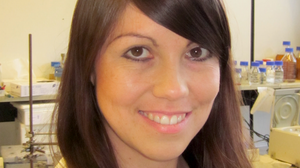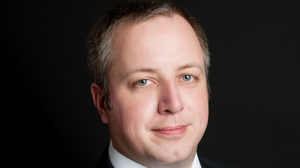Funded researchers: Dr. Kristina Elisabeth Overkamp, Dr. Christian Wiktor, Dr. Aychluhim D. Damtew & Dr. Christina Gonzalez Fernandez de Liencres
Dr. Kristina Elisabeth Overkamp
Biology and Biotechnology

Conventional cancer therapy such as radiation or chemotherapy affects not only malignancies, but also normal tissues and is therefore usually accompanied by intense side effects. On the contrary, cancer immunotherapy provides a much more targeted approach for treating malignancies with the promise of fewer side effects. In my Gateway Fellowship project hosted by Prof. Matt DeLisa at the Cornell University, Ithaca, NY, USA I will work on a novel strategy to develop new vaccines for use in cancer immunotherapy. This strategy involves engineering of the relatively simple and well-understood bacterium Escherichia coli to produce the main vaccine components in a highly specific and cost effective way. These main vaccine components include an antigen to trigger an immune response and an adjuvant to ensure that the response is efficient. By genetic and protein engineering I will design an E. coli-strain to produce the antigen (a highly specific carbohydrate structure) and to present this antigen on E. coli-derived outer membrane vesicles that serve as an adjuvant enhancing the immune response.
The Gateway Fellowship offers me not only the exciting chance to participate in fascinating research in an outstanding research group, but also the opportunity to strengthen my expertise in protein science and to learn a broad range of new immunological and bioengineering methods. The outcome of this project provides a basis for further investigations that will be subject of follow-up proposals. These investigations e.g. include the assessment of the specific antibody response to the vaccine antigen.
Dr. Christian Wiktor
Chemistry

Miniaturization and nanotechnology are common in our day and age. In scientific research there are two dominant questions when it comes to nanotechnology: How do we arrange matter on this scale and how do we find out if it worked?
Order in matter can be achieved by starting with a bulk piece of material and cleverly “cutting” it down to nanosize. It is however often easier and cheaper to start with individual molecules or salts and to grow nanostructures out of them. In this regard metal-organic frameworks (MOFs) are very promising materials. They consist of metallic centers which are connected to one another by organic molecules, the so called linkers. Since the geometry and connectivity of the individual parts is known or can be controlled they can be combined to self organized porous extended frameworks with typical void sizes of a few nanometers.
There is a multitude of different methods to characterize materials, but most of them yield information on the average properties of a material (composition, crystal structure,…). If there is an additional structure, e.g. all synthesized crystals should exhibit a certain size and should be arranged in a special way, most global methods would not yield this information on a local arrangement of crystals.
Transmission Electron Microscopy is one of the most versatile, direct, and useful methods to characterize the nanoregime in great detail on a local scale. It can be used to image individual atoms in a structure and to determine the composition of a sample in a given position. Since the instruments require highly trained personnel and are very expensive, they can be usually found gathered in microscopy centers.
The Gateway Fellowship allows me to spend nine months at the Canadian Center for Electron Microscopy, a well respected institute at the McMaster University in Hamilton, Canada. With the locally available state of the art equipment and expertise I will be able to conduct unprecedented experiments on surface grown MOF thin films. These experiments will include direct imaging of the MOF structure, but also spectroscopic studies of local compositions. The main goal will be to analyze the interfaces of the MOF and the material it is grown on, but also the interface of different MOFs. The obtained results will yield insight into the growth mechanism of MOFs and MOF thin films and will allow the design of new surfaces to grow MOF film on.
Dr. Aychluhim D. Damtew
Geosciences

Among the major requirements to understand the quantity and also quality of groundwater, a resource that support billions around the globe, measurement and modelling of recharge is imperative. This is particularly important in drier regions. The challenge, however, is heightened in drier and data scant regions. Our proposed research aims to address some of the challenges associated with the estimation of areal recharge using good spatial and temporal resolution, low cost, remotely sensed satellite data as opposed to a mere reliance on field-measured properties that often are expensive, represent localized area, and difficult to acquire them in the field. We intend to produce detailed recharge map for larger region which is characterized by varied hydro-climate (humid to arid) and where data is scarce.
NASA-launched satellite products including Moderate Resolution Imaging Spectroradiometer (MODIS), Tropical Rainfall Measuring Mission (TRMM) and Global Precipitation Measurement (GPM), and USGS-produced spectral image processing and hydrology programs will be used to facilitate this research. The hosting institute, United States Geological Survey (USGS), is well-known for the development of innovative methods and models that are widely in-use by the research community and industries all over the world. Production of valuable publications, computer programs in environmental, hydrological, and geological fields is a tradition of this institute. These and others not mentioned here make USGS an ideal place to conduct problem solving researches on current and future challenges of the society. I greatly acknowledge the support rendered by the Research School Plus under its Gateway Fellowship Program to conduct this timely research in this prestigious institute.
Dr. Christina Gonzalez Fernandez de Liencres
Neuroscience

Schizophrenia is a devastating disorder that affects about 1% of the population. There is a clinical state before full onset schizophrenia, called attenuated psychotic symptoms syndrome (APS), that is characterized by perceptual alterations and mild delusions that cause significant impairments in the affected patients and encourage them to seek medical help. Although some progress has been made regarding biomarkers that may predict the conversion of APS to chronic psychotic symptoms syndrome (CPS), there have hitherto been no studies that have investigated the potential role of neural oscillation synchronization while engaging in cognitive tasks in this conversion process.
During the GF project at the University of Chile, we aim to assess the cognitive deficits and electroencephalographic (EEG) biomarkers as a measure of neural (de)synchronization in a sample of patients with APS that developed into CPS, and compare it with those of patients with APS who have not developed CPS. Thus, this study intends to provide insights into the cognitive and EEG endophenotypes that may help predict which populations are at risk of developing psychosis. The presented proposal may aid in the design of techniques for the prevention and early diagnosis in individuals with high risk of psychosis.


